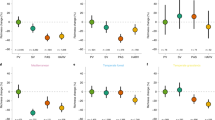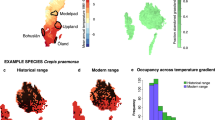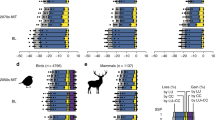Abstract
Climate change is expected to have significant influences on terrestrial biodiversity at all system levels, including species-level reductions in range size and abundance, especially amongst endemic species1,2,3,4,5,6. However, little is known about how mitigation of greenhouse gas emissions could reduce biodiversity impacts, particularly amongst common and widespread species. Our global analysis of future climatic range change of common and widespread species shows that without mitigation, 57±6% of plants and 34±7% of animals are likely to lose ≥50% of their present climatic range by the 2080s. With mitigation, however, losses are reduced by 60% if emissions peak in 2016 or 40% if emissions peak in 2030. Thus, our analyses indicate that without mitigation, large range contractions can be expected even amongst common and widespread species, amounting to a substantial global reduction in biodiversity and ecosystem services by the end of this century. Prompt and stringent mitigation, on the other hand, could substantially reduce range losses and buy up to four decades for climate change adaptation.
This is a preview of subscription content, access via your institution
Access options
Subscribe to this journal
Receive 12 print issues and online access
$209.00 per year
only $17.42 per issue
Buy this article
- Purchase on Springer Link
- Instant access to full article PDF
Prices may be subject to local taxes which are calculated during checkout



Similar content being viewed by others
References
Thomas, C. D. et al. Extinction risk from climate change. Nature 427, 145–148 (2004).
Malcolm, J. R., Liu, C., Neilson, R. P., Hansen, L. & Hannah, L. E. E. Global warming and extinctions of endemic species from biodiversity hotspots. Conserv. Biol. 20, 538–548 (2006).
Fischlin, A. et al. in IPCC Climate Change 2007: Impacts, Adaptation and Vulnerability (eds Parry, M. L., Canziani, O. F., Palutikof, J. P., van der Linden, P. J. & Hanson, C. E.) 211–272 (Cambridge Univ. Press, 2007).
Jetz, W., Wilcove, D. S. & Dobson, A. P. Projected impacts of climate and land-use change on the global diversity of birds. PLoS Biol. 5, 1211–1219 (2007).
Sekercioglu, C. H., Schneider, S. H., Fay, J. P. & Loarie, S. R. Climate change, elevational range shifts, and bird extinctions. Conserv. Biol. 22, 140–150 (2008).
Thuiller, W. et al. Consequences of climate change on the tree of life in Europe. Nature 470, 531–534 (2011).
Gaston, K. J. & Fuller, R. A. Commonness, population depletion and conservation biology. TREE 23, 14–19 (2008).
Elith, J. et al. A statistical explanation of MaxEnt for ecologists. Div. Distrib. 17, 43–57 (2010).
Brown, J. H. On the relationship between abundance and distribution of species. Am. Nature 124, 255–279 (1984).
Warren, R., Price, J., Fischlin, A., de la Nava Santos, S & Midgley, G. Increasing impacts of climate change on ecosystems with increasing global mean temperature rise. Climatic Change 106, 141–177 (2011).
Fee, E. et al. Scientific Perspectives After Copenhagen (European Union, 2010).
Den Elzen, M. G. J., van Vuuren, D. P. & van Vliet, J. Postponing emission reductions from 2020 to 2030 increases climate risks and long-term costs. Climatic Change 99, 313–320 (2010).
Lawler, J. J. et al. Projected climate-induced faunal change in the Western Hemisphere. Ecology 90, 588–597 (2009).
Connecting Biodiversity and Climate Change Mitigation and Adaptation: Report of The Second ad hoc Technical Expert Group on Biodiversity And Climate Change (Secretariat of the Convention on Biological Diversity, 2009).
Visconti, P. et al. Future hotspots of terrestrial mammal loss. Phil. Trans. R. Soc. B 366, 2693–2702 (2011).
Building A Low-carbon Economy: The UK’s Contribution to Tackling Climate Change (Climate Change Committee, 2008).
Dormann, C. F. Promising the future? Global change projections of species distributions. Basic Appl. Ecol. 8, 387–397 (2007).
Early, R. & Sax, D. F. Analysis of climate paths reveals potential limitations on species range shifts. Ecol. Lett. 14, 1125–1133 (2011).
Peters, G. P. et al. Rapid growth in CO2 emissions after the 2008–2009 global financial crisis. Nature Clim. Change 2, 2–4 (2012).
Nakicenovic N. et al. (eds) IPCC Special Report on Emissions Scenarios (SRES) (Cambridge Univ. Press, 2000).
Gohar, L. K. & Lowe, J. A. Summary of the emissions mitigation scenarios: Part 1 (Met Office Hadley Centre, 2009); available at http://www.metoffice.gov.uk/media/pdf/r/0/AVOID_WS1_D1_02_20090404.pdf.
Wigley, T. M. L. & Raper, S. C. B. Interpretation of high projections for global-mean warming. Science 293, 451–454 (2001).
Lowe, J. A. et al. How difficult is it to recover from dangerous levels of global warming? Environ. Res. Lett. 4, 014012 (2009).
Osborn, T. J. A user guide for ClimGen: A flexible tool for generating monthly climate data sets and scenarios. 19 (Climatic Research Unit, University of East Anglia, 2009).
Warren, R. et al. Development and illustrative outputs of the Community Integrated Assessment System (CIAS), a multi-institutional modular integrated assessment approach for modelling climate change. Environ. Modelling Softw. 23, 592–610 (2008).
Meehl, G. A. et al. The WCRP CMIP3 multi-model dataset: A new era in climate change research. Bull. Am. Meteorol. Soc. 88, 1383–1394 (2007).
Phillips, S. J., Anderson, R. P. & Schapire, R. E. Maximum entropy modelling of species geographic distributions. Ecol. Model. 190, 231–259 (2006).
Ramirez-Villegas, J. & Bueno-Cabrera, A. Working with climate data and niche modelling I. Creation of bioclimatic variables (International Center for Tropical Agriculture, 2009).
Phillips, S. J. & Dudik, M. Modelling of species distributions with MaxEnt: New extensions and a comprehensive evaluation. Ecography 31, 161–175 (2008).
Olson, D. M. et al. Terrestrial ecoregions of the worlds: A new map of life on Earth. Bioscience 51, 933–938 (2001).
Acknowledgements
We thank the Met Office Hadley Centre and the UK Department of Energy and Climate Change for use of the emission scenarios produced for the AVOID project. We also thank the Global Biodiversity Information Facility (GBIF), in particular T. Robertson, for the support provided during the completion of the analyses presented here. A portion of the funding for the Wallace Initiative came from a grant from the MacArthur Foundation to World Wildlife Fund, US. We wish to acknowledge S. Raper’s contribution to the production of the probabilistic climate model. We thank M. Brown at James Cook University for technical assistance. J.A.W. was financially supported, in part, by ARC Discovery Grant DP110104186. J.R-V. and A.J. were partly financially supported by the CGIAR Research Program on Climate Change, Agriculture and Food Security (CCAFS).
Author information
Authors and Affiliations
Contributions
J.P. assembled the team, coordinated and advised. R.W. generated and provided the climate projections in collaboration with T.J.O. and J.L. J.R-V. cleaned and processed the GBIF data. R.W., J.V., J.P., L.P.S., A.J. and S.E.W. designed the model experiments. J.V. performed the model experiments and analysis. R.W., J.V., J.A.W., J.R-V. and J.P. wrote the paper. I.A. facilitated and advised on computational issues surrounding modelling and data storage.
Corresponding author
Ethics declarations
Competing interests
The authors declare no competing financial interests.
Supplementary information
Rights and permissions
About this article
Cite this article
Warren, R., VanDerWal, J., Price, J. et al. Quantifying the benefit of early climate change mitigation in avoiding biodiversity loss. Nature Clim Change 3, 678–682 (2013). https://doi.org/10.1038/nclimate1887
Received:
Accepted:
Published:
Issue Date:
DOI: https://doi.org/10.1038/nclimate1887
This article is cited by
-
The performance of protected-area expansions in representing tropical Andean species: past trends and climate change prospects
Scientific Reports (2023)
-
Predicting climate heating impacts on riverine fish species diversity in a biodiversity hotspot region
Scientific Reports (2023)
-
Future temperature extremes threaten land vertebrates
Nature (2023)
-
Biotic interactions under risk: climate change drives spatial mismatch between a critically endangered tree and its seed dispersers and predators
Climatic Change (2023)
-
Identifying barriers and pinch-points of large mammal corridors in Iran
Journal of Environmental Studies and Sciences (2023)



